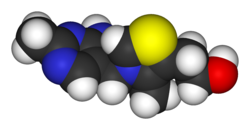Thiamine
2007 Schools Wikipedia Selection. Related subjects: Food and agriculture; General Chemistry
Thiamine or thiamin, also known as vitamin B1, is a colorless compound with chemical formula C12H17N4OS. It is soluble in water and insoluble in alcohol. Thiamine decomposes if heated.
Thiamine was first discovered in 1910 by Umetaro Suzuki in Japan when researching how rice bran cured patients of Beriberi. He named it aberic acid. He did not determine its chemical composition, nor that it was an amine. It was first crystallized by Jansen and Donath in 1926 (they named it aneurin, for antineuritic vitamin). Its chemical compostition and synthesis was finally reported by Robert R. Williams in 1935. He also coined the name for it, thiamin. There are three known thiamine phosphate derivatives: thiamine monophosphate (ThMP), thiamine diphosphate (ThDP) and thiamine triphosphate (ThTP).
Thiamine diphosphate (ThDP) or thiamine pyrophosphate (TPP) is a coenzyme for pyruvate dehydrogenase, α-ketoglutarate dehydrogenase, branched-chain alpha-keto acid dehydrogenase, and transketolase. The first two of these enzymes function in the metabolism of carbohydrates, while transketolase functions in the pentose phosphate pathway to synthesize NADPH and the pentose sugars deoxyribose and ribose. In general, TPP functions as a cofactor for enzymes that catalyze the dehydrogenation (decarboxylation and subsequent conjugation to Coenzyme A) of alpha-keto acids. TPP is synthesized by the enzyme thiamine pyrophosphokinase, which requires free thiamine, magnesium, and adenosine triphosphate.
Thiamine triphosphate (ThTP) was long considered a specific neuroactive form of thiamine. However, recently it was shown that ThTP exists in bacteria, fungi, plants and animals suggesting a much more general cellular role. In particular in E. coli it seems to play a role in response to amino acid starvation.
Nutrition
Also known as vitamin B1, thiamine plays an important role in helping the body convert carbohydrates and fat into energy. It is essential for normal growth and development and helps to maintain proper functioning of the heart and the nervous and digestive systems. Thiamine is water-soluble and cannot be stored in the body; however, once absorbed, the vitamin is concentrated in muscle tissue.
Deficiency
Systemic thiamine deficiency can lead to myriad problems including neurodegeneration, wasting, and death. A lack of thiamine can be caused by malnutrition, alcoholism, a diet high in thiaminase-rich foods (raw freshwater fish, raw shellfish, ferns) and/or foods high in anti-thiamine factors (tea, coffee, betel nuts).
Well-known syndromes caused by thiamine deficiency include Wernicke-Korsakoff syndrome and beriberi, diseases also common with chronic alcoholism.
Diagnostic Testing for B1 Deficiency
A positive diagnosis test for Thiamine deficiency can be assertained by measuring erythrocyte levels of transketolase.
Overdose
The only known cases of thiamine overdose occurred with thiamine injections. Thiamine injection may result in anaphylactic reactions.
Genetic diseases
Genetic diseases of thiamine transport are rare but serious. Thiamine Responsive Megaloblastic Anaemia with diabetes mellitus and sensorineural deafness (TRMA) is an autosomal recessive disorder caused by mutations in the gene SLC19A2, a high affinity thiamine transporter. TRMA patients do not show signs of systemic thiamine deficiency, suggesting redundancy in the thiamine transport system. This has led to the discovery of a second high affinity thiamine transporter, SLC19A3.
Mendelian Inheritance in Man (OMIM) 249270
Research
High doses
The RDA in most countries is set at about 1.4 mg. However, tests on volunteers at daily doses of about 50 mg have shown an increase in mental acuity.
Benefits for autism
Derrick Lonsdale lead a successful study on the treatment of autism spectrum children with thiamine. This work is controversial linking diet with autism.

